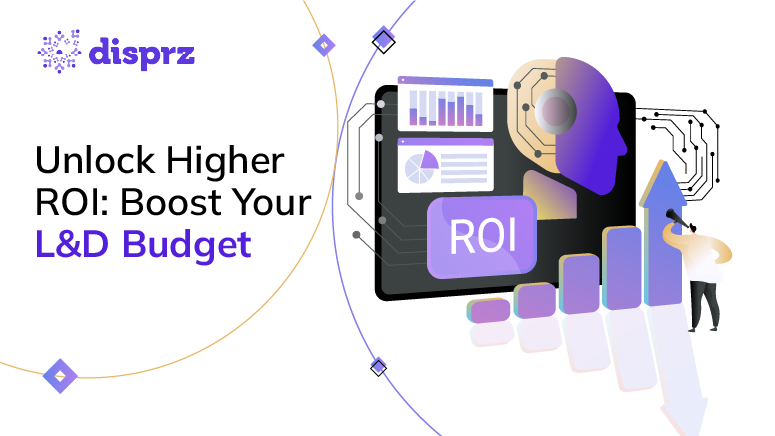Being an L&D professional is no easy feat, especially in today's era of evolving skilling trends and mounting challenges. Budget shortfalls can make the job even more daunting.
As per a report, 67% of organizations are expecting their learning and development budget to improve. Despite this positive outlook, it's crucial to recognize that a better budget alone doesn't guarantee maximizing your learning and development outcomes.
In an era where every dollar spent on L&D needs to count, understanding and optimizing learning ROI is paramount. This not only ensures that the budget is allocated wisely but also that the organization's workforce is equipped with the skills necessary to thrive in a rapidly changing world.
In this blog, we'll delve into the critical importance of learning ROI and its role in analytics builder shaping L&D budget decisions, ultimately helping organizations make the most of their investments in employee development.
How to Measure the ROI of L&D Initiatives?
- Define Clear Objectives: Start by setting specific, measurable, achievable, relevant, and time-bound (SMART) objectives for your L&D initiatives. Determine what you aim to achieve, such as improved employee performance, increased productivity, or reduced turnover. For example, sales training should enhance sales performance.
- Collect Data: Gather data before and after the L&D initiative to assess its impact. This could include pre-training assessments, course completion rate, platform adoption rate, post-training evaluations, performance metrics, and employee feedback. Ensure that you have baseline data to compare against.
- Calculate Costs: Calculate the total costs associated with the L&D initiative, including expenses for content creation, training delivery, technology, and staff time. Be comprehensive in your cost assessment.
- Measure Outcomes: Assess the outcomes and changes resulting from the L&D initiative. This might involve comparing performance metrics, such as increased sales, improved customer satisfaction, or reduced errors, before and after the training. Use quantitative and qualitative data to gauge the impact.
- Calculate ROI: To calculate ROI, use the formula: (Net Benefit / Total Cost) x 100. Net benefit is the difference between the gains (benefits) and the costs incurred. A positive ROI indicates that the initiative generated more value than it cost, while a negative ROI suggests the opposite. Ensure that ROI calculations consider both direct and indirect benefits.
Your next year’s L&D budget is dependent on this year’s learning ROI
The learning ROI is a powerful metric that can influence a budget allocation decision. So it is pivotal to measure and prove learning ROI. Project the value of your L&D efforts with compelling statistics. Numbers often grab attention, and top authorities are interested in lucrative numbers that contribute to their company’s growth or provide the best investment return.
If the top management has a clear picture that their L&D investment is boosting employee performance, then it would be easier to convince them to maximize the L&D budget. Hence, measuring the return on investment in learning and development initiatives is a must-do for all L&D professionals, regardless of the industry or company size.
Don’t ignore last year’s low learning ROI – Dig deep into the reasons
If you are already calculating the learning ROI and seeing some red flags, it’s time to address them rather than ignore them. The last year’s low ROI in learning indicates there are some loopholes in the learning and development path that you have defined for your organization. So, before planning the new year’s learning budget, take a step back and find the reasons for the low learning ROI for the previous year.
Here are a few common reasons for low learning ROI.
1. Content isn’t relevant to the learner
Content is the heart of a learning program; if it is irrelevant, employees won’t engage with it.
It is critical that the content resonates with the learner’s needs, skills gaps and job roles.
So, find out-
-
Was the content tailored to each employee’s learning requirements?
-
Was the content in sync with the company’s goals?
-
Did the content align with employee aspirations?
-
Did the content help in filling the skills gaps?
-
Was the language in which the content was presented easy to understand?
Learn how Petronas built a pipeline of leaders with personalized and tailored learning using Disprz LXP.
2. Courses weren’t assigned at the time of need
Just-in-time learning is a must in today’s modern learning environment to evolve consistently and confidently respond to changing challenges. If the courses aren’t assigned when the need arises, it will lead to a waste of time, money, and resources.
So, find out-
-
Are the learning programs fitting into the learner’s work routine?
-
Are the courses assigned to the learners at the right time?
-
Are the courses too long, leading to a drop off in the middle of the courses?
-
Do employees have the same experience while taking the courses through mobile devices?
-
Are the courses updated based on the changing trends, working challenges, learner interests, etc. and assigned to the learners on time?
Read how AIA insurance leveraged Disprz AI-powered platform to boost sales performance through effective learning strategies.
3. There is a lack of assessment and feedback
The absence of an assessment and feedback leads to ambiguity in learning and development. If the employees fail to understand a certain topic, they won’t be able to apply the learnings to work, leading to poor performance and lower return on investment.
So, find out-
-
If your learning programs have the right number of assessments?
-
Are the assessments carried out at regular intervals?
-
Are the employees taking the assessments or skipping them?
-
Are managers giving relevant feedback on poor assessment results?
Measuring impact for increasing learning ROI
Increasing ROI is critical for any business, and the best way of doing it is by focusing on the impact.
Let’s understand with an example.
A software company introduces a complex project management tool to enhance productivity. The L&D professional quickly subscribes to a learning solution without evaluating its effectiveness. Team members struggle to grasp the tool's intricacies and continue using older methods.
As a result, project timelines elongate, causing delays and client dissatisfaction. The rushed training program fails to empower employees, impacting the company's reputation and profitability. This illustrates the critical importance of thorough assessment and impact evaluation in L&D to ensure successful implementation and achieve desired outcomes.
The L&D impact can help in proving the learning ROI; hence it needs utmost attention.
So make sure you:
-
Measure the impact of the learning programs.
-
Be clear with the impact you would like to create with a specific learning program.
-
Create an assessment to ensure you achieve the learning impact goal you’ve set.
-
Add incentives or hooks that will propel the employees to complete the courses.
-
Monitor the employees’ performance to ensure you are able to drive the desired impact.
Using Philip’s ROI model for calculating learning ROI
We saw how critical the ROI metric is for increasing the learning budget.
But how to calculate learning ROI.
Well, Jack Philip’s ROI model can help in measuring learning ROI. The Phillips ROI methodology is an effective ROI calculation model that helps L&D professionals tie the cost of the learning and development programs with actual results. This model builds on the Kirkpatrick model to evaluate training and measure ROI. Kirkpatrick’s ROI model focuses on Reaction, Learning, Behavior, and Impact while Jack Philips’s ROI model moves ahead and adds the fifth level to calculate the ROI of a learning and development program.
The ROI model that Jack Philips proposed consists of five levels:
Level 1 – Reaction
At this level, L&D professionals gauge how employees have reacted to their learning and development programs. A short questionnaire or survey can help in collecting the data to find out what employees think about a specific learning program.
Level 2 – Learning
The second level of Jack Philip’s ROI model helps in evaluating what employees have learned from the learning programs. Multiple-choice questions or quizzes are used to assess if employees have enhanced their knowledge and acquired new skills.
Level 3 – Behaviour
Did the learning programs provide a behavioral change that the top management was expecting? Level 4 of Jack Philip’s ROI model helps in finding that out. It digs deeper into the “why” to understand why the learning program does or does not translate into workplace changes.
Level 4 – Impact
The business result and impact are measured in the 4th level of Philip’s ROI model. It helps assess if the learning and development succeeded in impacting the overall business key indicators.
Level 5 – ROI
The 5th level of Philip’s ROI model focuses on cost-benefit analysis. It links impact data to monetary benefits to see what tangible outcome the business has received by investing in learning and development.
Embracing technology for real-time learning analytics
Learning analytics can ease the tedious task of measuring learning ROI. Moreover, a modern tool like an analytics builder can be a helping hand in amassing critical learning insights for measuring ROI on learning and development initiatives. It enables you to convert raw data into actionable insights effortlessly. You can easily create a visual dashboard where you can see all the insights that are vital for your learning and development programs.
Below are a few metrics that you should track with any learning analytics tool to show the impact of the courses that you’ve been creating.
-
Course adoption metric – How many employees enroll on a course?
-
Course completion metric – How many employees complete the course?
-
Learning dropout metric – How many employees are not completing the course?
-
Assessment metric – How many employees are taking the assessments?
-
Assessment score – What’s scores are employees achieving after taking an assessment?
-
Post-training KPI score – Are the KPI score increasing after enrolling and completing the learning and development programs?
If these metrics display a positive number, then it will be easier to convince the management to increase the L&D budget for the next year.
Conclusion
Top management expects that the L&D professionals will maximize the L&D budget ROI. Therefore it is critical to construct ROI in learning and development to have a clear picture of the impact of the learning programs. The Jack Philips ROI model or Kirkpatrick model to evaluate training and measure ROI can help keep track of vital L&D metrics. By using these models in conjunction with a Learning Experience Platform (LXP) like Disprz, organizations can assess each level of training impact and calculate the actual ROI, providing concrete evidence of how the L&D programs contribute to the organization's bottom line.
Disprz LXP can help L&D professionals track and analyze key metrics, such as completion rates, assessment scores, skill acquisition, and even the business impact of training programs. It can also generate reports and dashboards that provide clear insights into the effectiveness of L&D efforts.
Schedule a demo today to see how the platform can assist you in achieving your L&D goals.











